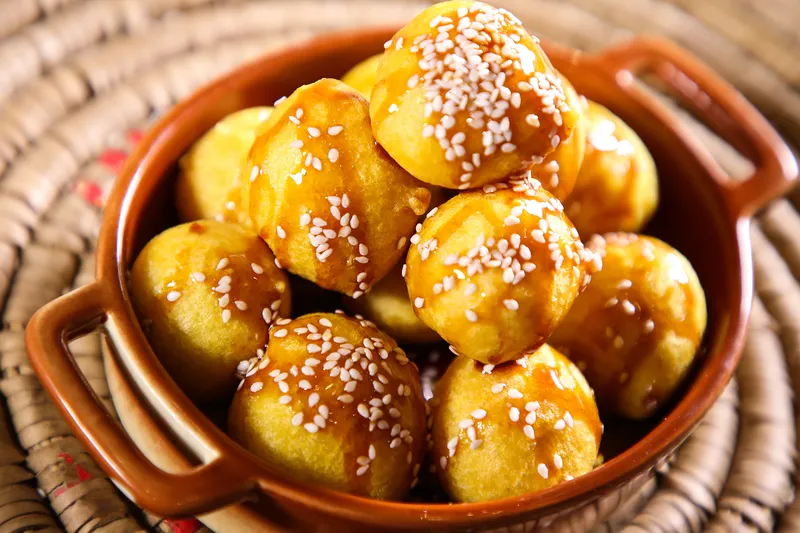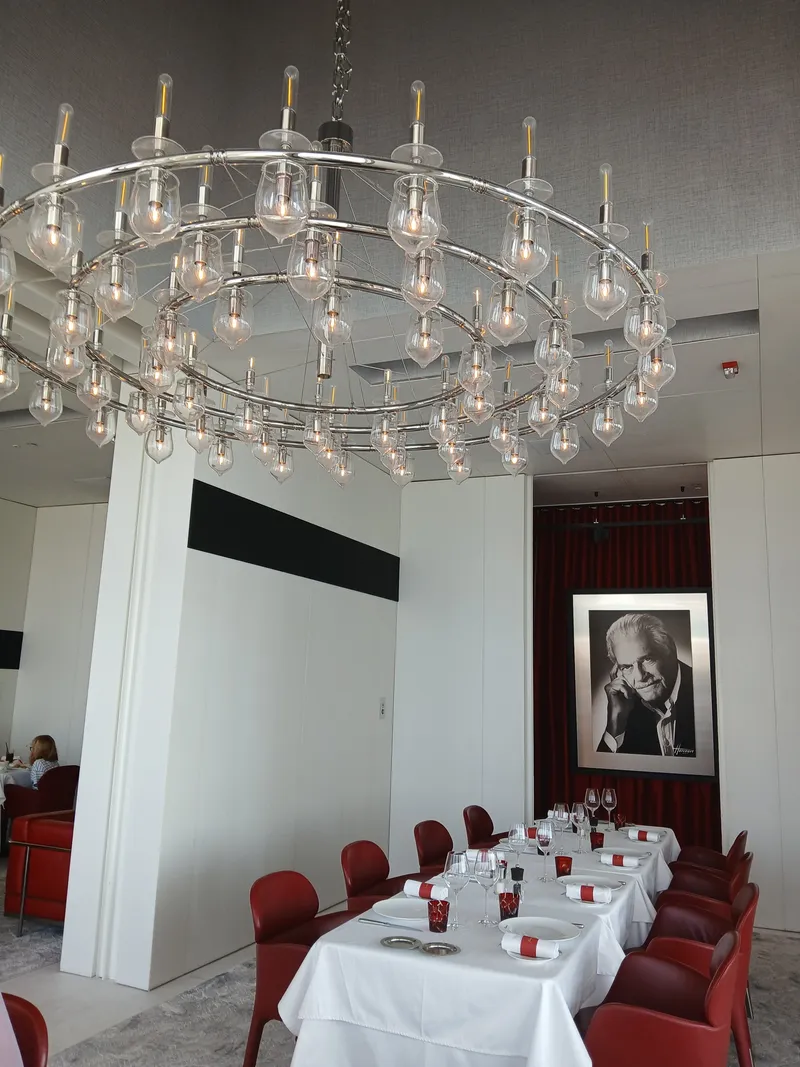A foodie’s guide to Abu Dhabi: Where to go for great food and warm conversations
Abu Dhabi not only offers traditional Emirati cuisine and fresh seafood, thanks to the city’s coastal heritage, but also food from around the world. And, not to forget, decadent desserts!
Luqaimat—a bite-sized, sweet, crispy dumpling covered in date syrup and sesame seeds—is a good friend finder.
Let me explain.
During my five-day trip to Abu Dhabi, the capital city of the United Arab Emirates, I observed people of all ages, whether they were dining at a Michelin-starred restaurant or attending an arts festival. They were all eager to enjoy these delicious dumplings.
Luqaimat is a great conversation starter, and it seems to bring people together—both expats and the friendly locals.
Made of leavened dough, luqaimat tastes like doughnut holes but is far less sweet and has earthy notes contributed by date syrup and sesame seeds.

If you are new to the city and don’t know where to start, luqaimat is a good bet. But make sure you follow it up with other options. After all, Abu Dhabi is a hub for food lovers!
With so many expats making it their home away from home, the city offers cuisines from around the world and, of course, traditional Emirati and Arabic foods.
While the internet is filled with recommendations on where to eat in the city, finding one’s way through the maze can be tough. So we are here to help you explore Abu Dhabi’s food scene and indulge in all that it has to offer—with a curation of elegant places and foods to choose from.
Erth for Emirati food
A Michelin-star restaurant, Erth exudes Emirati warmth and hospitality. Located in the city’s heart, within the Al Hosn cultural area, Erth is a striking example of Brutalist architecture, characterised by minimalist design and exposed concrete in both the walls and the floor.
A shallow pool of water adds to the charm of the place, especially at night.
We were seated at a table beside the pool, and it took some time to adjust to the intimate glow of table lamps in an otherwise dimly lit area.
Our meal began with a salad comprising locally farmed salmon crudo, beetroot, and chami salad. Chami is a traditional Emirati soft cheese: it is crumbly, slightly salty, and delicious.
For the main course, we had Emirati ghee chicken salona, which is chicken cooked in a tomato sauce, served with chami cheese naan and Emirati spiced Hasselback potatoes with sumac, chives and parsley. The chicken was tender, and the sauce was slightly sweet.
This was followed by the saffron dates laban, which was excellent, but given the food’s huge portion sizes, it was a bit hard to finish the drink. To be fair, I had been warned about it but the heart wants what it wants!
For desserts, we were spoilt with options: there was Erth’s signature El Ferni, liwa date sphere batheeta and, of course, the crowd favourite luqaimat.
The description of El Ferni–cream sandwiched between crispy phyllo sheets, with pistachio praline and saffron with Sidr honey and orange blossom sauce (phew!)—might make it sound decadent, but the dessert was light and subtle. It was a true beauty in both presentation and taste.
On the other hand, Liwa dates sphere batheeta, a cake made of dates and batheeta powder, and topped with chocolate sauce and vanilla ice cream–was as indulgent as it sounds. Batheeta or batheet is a traditional Emirati dessert made of dates and toasted flour.
Local fare at Traditional Handicrafts Festival
We also had the opportunity to taste Emirati food at the Traditional Handicrafts Festival in the city of Al Ain—and it was a treat, both in terms of food and hospitality.
We tried harees, which is made from crushed wheat and meat. The slow-cooked dish resembles daleem or haleem, which is popular in India, especially during Ramadan. Harees, however, has fewer spices.
Wark enab or dolma was a surprisingly sour dish made with grape leaves stuffed with rice and herbs.
An honourable mention is balaleet, which is cooked vermicelli with hints of cardamom and saffron. The dish is mildly sweet and comforting. I ate it for breakfast for five consecutive days and still couldn’t get enough!
Zali for traditional Lebanese food
Located in the heart of Al Bateen is Zali, a Lebanese restaurant that first opened its doors in 2021 in Indonesia.
Launched late last year in Abu Dhabi, Zali brings what’s described as “wholesome and hearty” homemade Lebanese food. The menu includes hot and cold mezze, a platter that comes with falafel, kabab, beetroot salad, aubergine moutabbal, cherry tomato salad, and an Aleppo pepper sauce; kafta and batata, a type of kabab served with potato, a rich tomato sauce, and vermicelli rice; aubergine maklouba, which had aubergine served with tender pieces of lamb and seasoned rice.

Traditional food served at Zali in Abu Dhabi; Image courtesy: Department of Culture and Tourism, Abu Dhabi
We also tried the pan-seared lamb chops, which were paired beautifully with the slightly sweet and herb-y yogurt sauce and crispy potato wedges.
The dessert menu looked tempting: mouhallabiya rolls, which are pastry rolls filled with creamy muhallabiya, a traditional milk pudding; halawa and pistachio and zalitella saj, which is saj bread filled with creamy chocolate-hazelnut spread.
But alas! We had to cancel our dessert order since we were so full at the end of the meal.
Although on the expensive side, Zali offers generous portion sizes. So do pay attention while ordering, so that you do not miss the desserts.
Side note: Located on the waterfront, Zali offers an incredible view of the marina. The interior is sleek and rustic, with floor-to-ceiling windows and wooden furniture that brings a laidback tropical yet modern vibe to the place.
French fine dining at Fouquet’s Abu Dhabi
Located within the Louvre Abu Dhabi, Fouquet’s needs no introduction. One can sit at the restaurant for hours and yet constantly find something new to look at.
The interiors feature distinct red leather armchairs, elegant chandeliers, and monochrome celebrity portraits from Studio Harcourt—a photography studio founded in 1934—which provide homage to the restaurant’s Parisian roots.

Fouquet's interiors feature red leather armchairs, elegant chandeliers and monochrome paintings.
As for the food, Michelin-starred Chef Pierre Gagnaire has created a unique culinary experience that blends classic French cuisine with international flavours.
The menu is vast and offers something for everyone—from roasted corn-fed chicken breast served with mashed potato and pan-fried Omani prawns with satay sauce (a creamy rich sauce with peanuts, ginger and garlic) to braised lamb shoulder with carrot hummus and lentil salad.
Desserts at Fouquet’s are exceptional: fresh exotic fruit pavlova with coriander, mango vanilla sorbet, meringue; classic tiramisu with mascarpone cream; biscuit souffle al chocolat with Venezuelan chocolate and vanilla ice cream.
Each dessert is in a league of its own.
In search of more desserts
I couldn’t conclude this article without mentioning the classic Middle Eastern desserts that Abu Dhabi has to offer.
Conversations at shopping centres with the city folk would eventually lead to food and, from there, to desserts. One of the recurring suggestions was to try local bakeries and sweet shops and not stick to the popular stores or prepacked desserts.
And the experience was incredible.
All the local bakeries and sweet shops had friendly staff and an incredible assortment of sweets: several varieties of the flakiest baklavas; mouth-watering kanafeh; basbousa, a delicate semolina cake soaked in syrup; cream rolls, cakes and biscuits.
Special mention to Hanon Feras Sweets and Al Aqsaa Sweets, which had melt-in-the-mouth baklava and kanafeh. What stood out was the remarkable patience of the staff. Despite the rush of customers, they took the time to explain the various fillings in the sweets.
Here’s a little tip. Even if you try the popular restaurants and sweet shops recommended on the internet, also check out the smaller, not-so-popular shops you may find on the way. They are bound to have some of the best food, accompanied by warm conversations.
The author was in Abu Dhabi on the invitation of the Department of Culture and Tourism, Abu Dhabi.
Edited by Swetha Kannan







